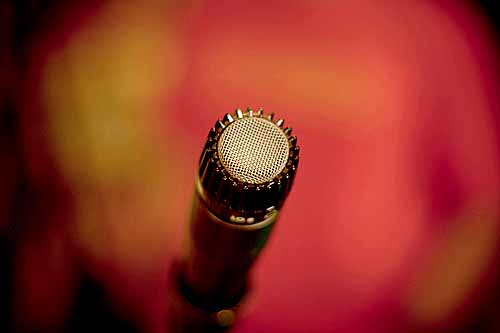While the requirements for a good talkback mic aren’t as specific, there are some factors you probably want to look for. Many studios go with a gooseneck-style microphone since those can be permanently mounted to the mixing desk for hands-free use. The pickup pattern of the mic is also important, to make sure that you can communicate clearly with the musicians without interfering with what they’re playing or hearing.
Below are our recommendations for the 4 best talkback mics on the market:
Astatic 22-inch Condenser Cardioid Mini Gooseneck Talkback Microphone
The sound capture compact condenser mic is the first thing worth noting. It’s designed for spoken human voices and optimized to those frequencies, so you know what you say into it will be clear and audible on the other side. It uses a cardioid pattern that limits background interference while still beautifully capturing your voice. There’s even a windscreen included to prevent unwanted extra noise.
The build of the Astatic Gooseneck mic is also well-suited to many recording studios (see full specs). It has a long 22-inch, fully-adjustable neck, so you can use it easily even if you move around a lot in the booth. The XLR connection mounts directly onto your mixing board so it’s easy to set-up and just as easy to use. Absolutely crisp vocal reproduction in a durable and compact package that will look great on any mixing desk makes this a very appealing option.
Samson CM20P Gooseneck Podium Talkback Mic
The CM20P is Samson’s version of the gooseneck condenser microphone. Like the Astatic, the mic uses a cardioid polar pattern and is mounted on a fully-adjustable gooseneck. There are quite a few differences in the details, however, both in the exterior design and the inner workings.
Let’s start with the sound. The windscreen on this model is impressive, with virtually no splosives at any distance. The microphone itself doesn’t provide as crisp of a response as higher-end condensers, but it is plenty clear enough for communication within the studio.
It’s also very attractive design-wise. The 20-inch neck gives you a lot to work with, and both the top and bottom are flexible, too. This makes it a great option for a cramped or oddly-spaced booth that requires maximum maneuverability out of your talkback mic. If clarity and ease of use are your main concerns, the CM20P is easily one of the best talkback mics for the money.
FIFINE Desktop Gooseneck Microphone
Looking for a budget-friendly gooseneck microphone? Here’s an option from FIFINE that will set you back just a song and still give you everything you need from a talkback mic. This includes a mute button and easy to access volume control right on the base. It’s also built to be plug-and-play, no drivers required, making setup a breeze.
The FIFINE Gooseneck Microphone connect via USB, which may mean using an adapter in certain studio set-ups. The gooseneck is easy to adjust and re-position, and both the cable and the shaft are a convenient length. We also appreciate the noise-cancelling features on the microphone itself, limiting background noise from interfering with your communication.
Shure SM35-XLR Headset Condenser Talkback Microphone
Gooseneck mics are an affordable way to communicate in the studio, but if you’re looking for the ultimate in hands-free convenience, a headset microphone like the SM35 from Shure just might be the way to go. Since your mouth is pretty much always the same distance from the microphone, you’ll get a consistent volume and response no matter where you are.
Shure are giants in the recording industry. Talkback mics might not be their headliner, but they put the same quality components into their behind-the-scenes equipment as they do into their instrumental and vocal mics. The SM35 comes in both a wired version with an XLR connection (see full specs). Don’t get too excited when you look at the price difference; the wireless version does require a body pack to work. Both versions will give you the same reliable signal reproduction.
The sound quality is fantastic on the SM35, especially considering the compact size of the microphone. It’s lighter-weight than many microphones, making it more comfortable to wear for a long time. It’s even durable enough to wear for live shows, making it easily the most versatile option on this list.
So Which Is the Best Talkback Mic?
Typically when you’re shopping for microphones the quality of the sound capture is the most important quality. When it comes to talkback mics, though, this is honestly a secondary consideration. They’re strictly for facilitating communication; no sound recorded through them will ever be audible on a recorded track. As long as the people in the booth can understand you when you speak through it, the microphone is of sufficient quality.
So what traits are important? Convenience is the most important consideration for most users. You want to look for something that will fit well with your existing equipment. This means both that it’s an appropriate size and with a long enough neck, and that the electronics are compatible.
Goose-neck designs are far easier to install and work with than a standard mic on a stand, even an overhead stand. This is especially true if you like to move around while you’re recording. Headset microphones offer the ultimate in mobility, if that’s your primary concern. They tend to cost a bit more, as well, but are still incredibly affordable compared to the mics you buy for recording.
Even the best talkback mics are relatively small investments that can nonetheless make a big difference in facilitating communication within a recording booth. The four models above are all strong contenders, giving you reliable performance at a great value. Good luck!








